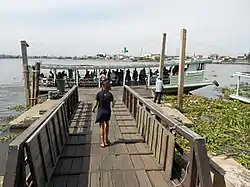Mueang Samut Sakhon District
Mueang Samut Sakhon (Thai: เมืองสมุทรสาคร, pronounced [mɯ̄a̯ŋ sā.mùt sǎː.kʰɔ̄ːn]) is the capital district (amphoe mueang) of Samut Sakhon Province, central Thailand.
Mueang Samut Sakhon
เมืองสมุทรสาคร | |
|---|---|
.jpg.webp) Ban Kalong Halt on the Maeklong line, Tambon Kalong, Mueang Samut Sakhon District | |
 District location in Samut Sakhon Province | |
| Coordinates: 13°32′54″N 100°16′24″E | |
| Country | Thailand |
| Province | Samut Sakhon |
| Area | |
| • Total | 492.04 km2 (189.98 sq mi) |
| Population (2017) | |
| • Total | 293,723 |
| • Density | 596.94/km2 (1,546.1/sq mi) |
| Time zone | UTC+7 (ICT) |
| Postal code | 74000 |
| Geocode | 7401 |
History
Mueang Tha Chin dates back to the Ayutthaya Kingdom. The city was managed by the Defence ministry. King Maha Chakkraphat ordered Mueang Sakhon Buri to be established. King Mongkut (Rama IV) changed the city name to Samut Sakhon. In 1897 Mueang Samut Sakhon a district.
Locals still refer to Mueang Samut Sakhon District by its old name, Mahachai.
Geography
Neighboring districts are (from the west clockwise): Mueang Samut Songkhram of Samut Songkhram Province; Ban Phaeo and Krathum Baen of Samut Sakhon Province; and Bang Bon and Bang Khun Thian of Bangkok. To the south is the Bay of Bangkok.
Environment
Samut Sakhon Province has more than 6,000 small- and medium-sized factories, many of them in this district. Soil and water samples from the industrial area of Mueang District were found to be contaminated with high levels of arsenic, lead, cadmium, chromium, zinc, copper, and nickel. High levels of persistent organic pollutants (POPS), byproducts of industrial processes, were present in eggs from free-range chickens. An egg tested by researchers was found to have 84 nanograms per kilogram of dioxins and furans, a level 33 times higher than the safety limit observed by the European Union.[1]
Administration
The district is divided into 18 subdistricts (tambons), which are further subdivided into 116 villages (mubans). Samut Sakhon itself has city status (thesaban nakhon) and covers the three subdistricts Maha Chai, Tha Chalom, and Krokkrak. Bang Pla is a subdistrict municipality (thesaban tambon) which covers parts of the same-named subdistrict. Three other subdistricts completely form a subdistrict municipality: Na Di, Bang Ya Phraek and Tha Chin. The non-municipal area is administered by 12 tambon administrative organizations (TAO).


| No. | Name | Thai | Villages | Pop. |
|---|---|---|---|---|
| 1. | Mahachai | มหาชัย | - | 68,208 |
| 2. | Tha Chalom | ท่าฉลอม | - | 8,604 |
| 3. | Krokkrak | โกรกกราก | - | 5,052 |
| 4. | Ban Bo | บ้านบ่อ | 9 | 8,661 |
| 5. | Bang Tho Rat | บางโทรัด | 10 | 8,585 |
| 6. | Kalong | กาหลง | 8 | 4,822 |
| 7. | Na Khok | นาโคก | 6 | 3,750 |
| 8. | Tha Chin | ท่าจีน | 7 | 12,317 |
| 9. | Na Di | นาดี | 9 | 26,654 |
| 10. | Tha Sai | ท่าทราย | 8 | 29,972 |
| 11. | Khok Krabue | คอกกระบือ | 6 | 9,737 |
| 12. | Bang Nam Chuet | บางน้ำจืด | 6 | 13,505 |
| 13. | Phanthai Norasing | พันท้ายนรสิงห์ | 8 | 29,059 |
| 14. | Khok Kham | โคกขาม | 10 | 22,622 |
| 15. | Ban Ko | บ้านเกาะ | 8 | 10,237 |
| 16. | Bang Krachao | บางกระเจ้า | 9 | 10,849 |
| 17. | Bang Ya Phraek | บางหญ้าแพรก | 6 | 24,712 |
| 18. | Chai Mongkhon | ชัยมงคล | 6 | 4,002 |
References
- Kongrut, Anchalee (9 February 2020). "Pollution taints seaside community's prosperity". Bangkok Post. Retrieved 10 February 2020.